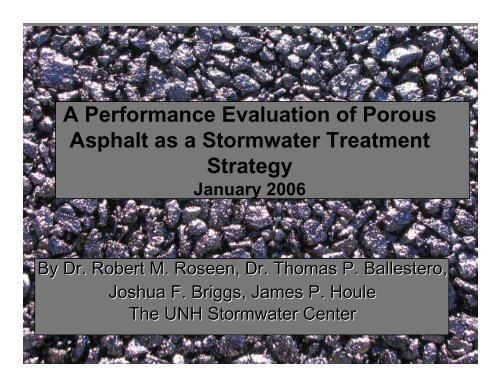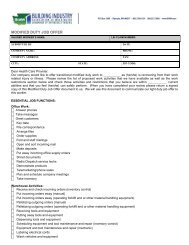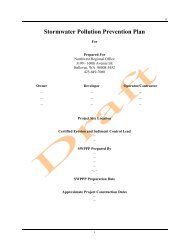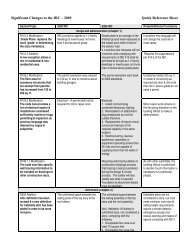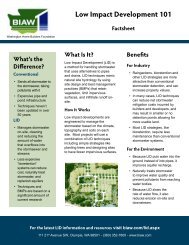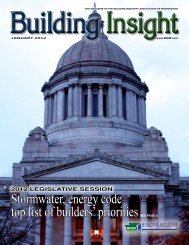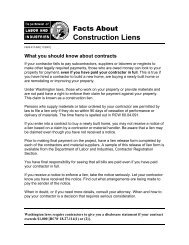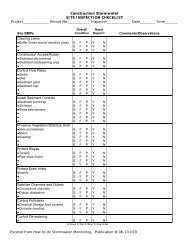A Performance Evaluation of Porous Asphalt as a Stormwater ...
A Performance Evaluation of Porous Asphalt as a Stormwater ...
A Performance Evaluation of Porous Asphalt as a Stormwater ...
You also want an ePaper? Increase the reach of your titles
YUMPU automatically turns print PDFs into web optimized ePapers that Google loves.
A <strong>Performance</strong> <strong>Evaluation</strong> <strong>of</strong> <strong>Porous</strong><strong>Asphalt</strong> <strong>as</strong> a <strong>Stormwater</strong> TreatmentStrategyJanuary 2006By Dr. Robert M. Roseen, Dr. Thom<strong>as</strong> P. Ballestero,Joshua F. Briggs, James P. HouleThe UNH <strong>Stormwater</strong> Center
<strong>Stormwater</strong> Center Crew• Dr. Thom<strong>as</strong> P. Ballestero--- PI• Dr. Robert Roseen--Director• Jamie Houle—Facility manager• Pedro Avellaneda—Site wide• Josh Briggs---<strong>Porous</strong> <strong>Asphalt</strong>• Robert Wildey---Micro• Darlene Brown, Tim Puls, Greg Sine, andJoel BallesteroThe UNH <strong>Stormwater</strong> Center2005
Research ObjectiveTo evaluate porous <strong>as</strong>phalt a stormwatermanagement strategy– The design sizing criteria w<strong>as</strong> b<strong>as</strong>ed on the needto provide storage for a 10 year rainfall event. Thatentails 4.3” <strong>of</strong> rainfall storage within approximately15” <strong>of</strong> materialsThe UNH <strong>Stormwater</strong> Center2005
Study Details• March 2005-Present: 4 storms included, 5 add’tl to beanalyzed, challenged by no-flow events• A paired design: half dense mix <strong>as</strong>phalt, half porous,<strong>as</strong>phalt• Located at the UNH <strong>Stormwater</strong> Center in Durham.• Part <strong>of</strong> a 600+ space parking lot is standard dense mix<strong>as</strong>phalt used near capacity throughout the academicyear.• Activity is a combination <strong>of</strong> p<strong>as</strong>senger vehicles androutine bus traffic.• Time <strong>of</strong> concentration= 6 minutes, slopes = 1%• Frequent plowing, salting, and sanding during the wintermonths.• Contaminant concentrations are above or equal tonational norms for parking lot run<strong>of</strong>f.The UNH <strong>Stormwater</strong> Center2005
DESIGN SOURCES• Modified After Vermont Agency Of TransportationSpecifications for Open Graded Friction Course (Section409).• Michelle Adams, Cahill Associates, EnvironmentalConsultants, 104 South High Street, West Chester, PA19382• <strong>Porous</strong> <strong>Asphalt</strong> Pavements (2004) Information Series131. The National <strong>Asphalt</strong> Pavement Association,Lanham, MD.• Design, Construction, and Maintenance <strong>of</strong> Open-Graded<strong>Asphalt</strong> Friction Courses (2002). Information Series 115.The National <strong>Asphalt</strong> Pavement Association, Lanham,MD.The UNH <strong>Stormwater</strong> Center2005
<strong>Porous</strong> <strong>Asphalt</strong> Cross-Section4” <strong>of</strong> porous <strong>as</strong>phalt4” choker coarse <strong>of</strong> ¾”crushed stone8-12” thickness <strong>of</strong> porousreservoir subb<strong>as</strong>eThe UNH <strong>Stormwater</strong> Center2005
Methods• Data collection and storage byISCO 6712FR RefrigeratedSampler• Precipitation - Tipping bucketrain gauge (ISCO 674)• Flow – Compound weir (6”Thelmar) w/ ISCO 730 BubblerThe UNH <strong>Stormwater</strong> Center2005
Data Synthesis• Hyetograph• Hydrograph: delay coeff and lag timeby centroid analyses• Cold Climate Assessment• Infiltration Rates• Event Mean Concentration (EMC)The UNH <strong>Stormwater</strong> Center2005
What is <strong>Porous</strong> <strong>Asphalt</strong>?
Origins <strong>of</strong> <strong>Porous</strong> <strong>Asphalt</strong> - OGFC• <strong>Porous</strong> <strong>as</strong>phalt is a modification <strong>of</strong> Open GradedFriction Course (OGFC)• ‘<strong>Porous</strong> <strong>as</strong>phalt’ for our purposes is a single pavementlayer used for low traffic are<strong>as</strong> that allows subsurfaceinfiltration to an open bottom reservoir b<strong>as</strong>e• OGFC:– Is a coarse-graded <strong>as</strong>phalt mixture overlying animpervious b<strong>as</strong>e, typically used on highways– Water drains through OGFC to impervious layer,then to shoulder– Improves traction, reduces spray, deadens tire noise– Is cost competitive with Hot Mix <strong>Asphalt</strong> (HMA)– Some evidence that stormwater movement throughOGFC improves water qualityThe UNH <strong>Stormwater</strong> Center2005
<strong>Porous</strong> <strong>Asphalt</strong>Pavement• = binder + aggregate• Modification <strong>of</strong> OpenGrade Friction Course(OGFC)• Aggregate gradation iscoarse w/ few fines• <strong>Asphalt</strong> binder <strong>of</strong>tenmodified (polymers,fibers) but notnecessary• Air voids 18-22%Standard <strong>Porous</strong> <strong>Asphalt</strong> MixesUS StandardSieve Size1/2 in.3/8 in.#4#8#16#30PercentP<strong>as</strong>sing10095351510Percent bituminous 5.75-6.0%by weight2
I-95 North, June 2005, NO OGFC overlay
I-95 North, June 2005, OGFC overlay
I-95 South, June 2005, NO OGFC overlay
Misconceptions About<strong>Porous</strong> <strong>Asphalt</strong>• Freezes F<strong>as</strong>ter - rather incre<strong>as</strong>ed speed in thawingcompared to DMA, due to flow through by meltwater(Backstrom, 2000)• Higher Maintenance and Cost - overall $$ iscomparable• Clogs - sure but still maintains high IR (10+ in/hr)• Cannot Plow, Salt, or De-Ice - not true• Heaving and Shifting - reduced due to vadose zonedisconnect• Lower Lifespan - incre<strong>as</strong>ed due to reduced freeze thaw(Spelic, 2003)
Monitoring and <strong>Performance</strong> DataThe UNH <strong>Stormwater</strong> Center2005
Surface Inundation Test• Surface Inundation Testprovides estimate <strong>of</strong>infiltration rate (Bean,2004)• 1-foot dia. SS columnsealed to pavement withputty or weighted b<strong>as</strong>e withfoam• 5 gallons water poured intocylinder; me<strong>as</strong>ure time toinfiltrate into pavementsurfaceThe UNH <strong>Stormwater</strong> Center2005
Surface Infiltration Rates 20057,000Surface Infiltration Rate, cm/hr6,0005,0004,0003,0002,0001,000;Point APoint BPoint C01/1 2/20 4/11 5/31 7/20 9/8 10/28The UNH <strong>Stormwater</strong> Center2005
Surface Infiltration Rates at 3 Locations for 2005Surface Infiltration Rate, cm/hr7,0006,0005,0004,0003,0002,0001,0000A B CLocation on <strong>Porous</strong> <strong>Asphalt</strong> PavementThe UNH <strong>Stormwater</strong> Center2005
Frost Penetration• Field <strong>as</strong>sembled frost gauge(CRREL, 1976)• Solinst LT Levelogger placedat variable levels in a shallowGW wellThe UNH <strong>Stormwater</strong> Center2005
Frost PenetrationWinter 2005 Frost DepthsAir Temperature, deg. C20151050-5-10-15-20Air Temp.Avg. Air Temp.Frost Depth3/2 3/7 3/12 3/17 3/22 3/27 4/10.00.20.40.60.81.0Frost Depth, ftThe UNH <strong>Stormwater</strong> Center2005
Filter Media Frost Penetration1/13/2005 1/25/2005 2/4/2005 2/16/2005 2/25/2005 3/8/2005 3/15/2005 3/28/200501245403530Inches34567B-SandD-BioG-GravelRainAve. Temp2520151050Temp *FThe UNH <strong>Stormwater</strong> Center2005
Rainfall and Run<strong>of</strong>fMarch 28, 2005 Storm and Snowmelt EventFlow (gpm)3530252015105Influent Flow<strong>Porous</strong> <strong>Asphalt</strong> FlowRainfallAntecedent Dry Period (days): 3.4Rainfall Depth (in): 2.35Peak Flow Reduction: 60%Lag Time (min): 750Delay Coefficient: 2.00.000.010.020.030.040.050.060.075-Minute Rainfall (in.)00 500 1,000 1,500 2,000 2,500 3,0000.08Time (min)The UNH <strong>Stormwater</strong> Center2005
Rainfall and Run<strong>of</strong>f (cont’d)May 21, 2005 Storm EventFlow (gpm)201816141210864200 500 1000 1500 2000 2500 3000 3500 4000 4500 5000Time (min)Antecedent Dry Period (days): 3.0Rainfall Depth (in): 0.91Peak Flow Reduction: 80%Lag Time (min): 1,320Delay Coefficient: 3.700.010.020.030.040.050.065-M inute Rainfall (in)The UNH <strong>Stormwater</strong> Center2005
TSS <strong>Performance</strong>90.00TSS Event Mean Concentration (mg/L80.0070.0060.0050.0040.0030.0020.0010.000.00InfluentJ-PASThe UNH <strong>Stormwater</strong> Center2005
DIN <strong>Performance</strong>1.6DIN Event Mean Concentration (mg/L1.41.21.00.80.60.40.20.0InfluentJ-PASThe UNH <strong>Stormwater</strong> Center2005
TPH-D <strong>Performance</strong>TPH-D Event Mean Concentration (ug/L1,0008006004002000InfluentJ-PASThe UNH <strong>Stormwater</strong> Center2005
Zinc <strong>Performance</strong>Zn Event Mean Concentration (mg/L0.100.080.060.040.020.00InfluentJ-PASThe UNH <strong>Stormwater</strong> Center2005
Conclusions• Peak flow and volume reduction are substantialdependenton subdrain design• Water quality performance is similar to sand filters---excellent removal- except for NO3• IR rates declined initially and appear to havestabilized• Long term infiltration rates will need to be monitored• Coring is needed to determine mechanism <strong>of</strong>decre<strong>as</strong>ed IR• Appears to be a sound alternative to conventionalBMPs• Maintenance impacts will need to be evaluatedThe UNH <strong>Stormwater</strong> Center2005
AcknowledgementsFunding Source:
Questions?


